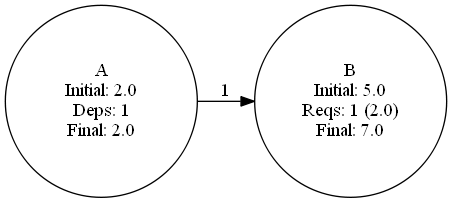I recently spent a week locked in a boardroom with my management team and chairman developing our company strategy for short, medium, and long-range horizons. At one point during that week I stumbled upon a new way of representing and evaluating choices between different projects, each with different resource requirements and benefiting different customers or segments. At its core, it's a directed graph.
In this simplest of examples, there's a project A which costs 2 units. Project B depends upon 100% of A and itself costs 5 units. What does B really cost? B + 1.0 * A = 5 + 2 = 7 units.
Simple enough, right? Nodes are projects, and have costs. Edges are dependencies between projects, and have weights. The full cost of any project is the weighted sum of all its dependencies and its own internal cost.
Simple enough, right? Nodes are projects, and have costs. Edges are dependencies between projects, and have weights. The full cost of any project is the weighted sum of all its dependencies and its own internal cost.

 RSS Feed
RSS Feed